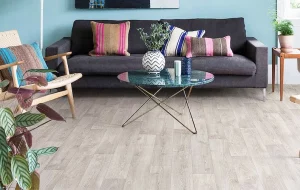
Luxury vinyl plank (LVP) flooring has the same ease of care and cleaning as sheet vinyl but is more durable and comfortable underfoot. PVC is used in both types of flooring.
Sheet vinyl is a thin, flexible roll or tile that has a clear protective coating over the pattern layer. To improve strength and rigidity, luxury vinyl includes additional and thicker layers, including a transparent top-coat layer, a design layer with the printed image, a cushion layer of foam, a fibreglass backing layer, and a rigid PVC backing layer. Luxury vinyl flooring is a distinct sort of flooring, despite the fact that it is manufactured of the same PVC vinyl as conventional vinyl flooring. Luxury vinyl is available in multi-ply planks or tiles with wear layers ranging in thickness from 2 to 8 mm. Luxury vinyl planks are far thicker than normal vinyl, giving them a semi-rigid appearance. Luxury vinyl planks (LVP) and tiles (LVT) are installed using a click-and-lock mechanism similar to laminate flooring.
To keep LVP or LVT floors in high-traffic areas of a home looking their best, they should be dry-mopped or vacuumed daily to remove grit that can cause scratches. Spills should be wiped up immediately to prevent stains that may be more difficult to remove later. The floors should be thoroughly cleaned at least weekly.
Here is how to clean your LVP flooring in a few simple steps:
-
- Remove loose dirt and dust – Dirt and grime can scratch the surface of LVP flooring. Daily sweeping, vacuuming, and mopping are strongly recommended in high-traffic areas. If you choose to vacuum, make sure you disengage the beater bar of your vacuum cleaner or choose one without a beater bar – it may damage the surface.
- Pick the right cleaning solution – A variety of professional cleaning solutions are effective for cleaning LVP and LVT flooring. Before using a business floor cleaner, however, study the label to determine the product contents and whether it is safe for LVP flooring. Ammonia-containing products can damage vinyl surfaces. Mop and shine products might leave a film on the floor, attracting more dirt.
If desired, you may easily make a cleaning solution from household items that will clean LVP flooring without causing irreversible harm.
-
- Mix your own cleaning solution – Add a few drops of liquid dishwashing soap to a mop bucket or deep sink of warm water. For kitchen floors, use a liquid soap with a degreaser, such as Dawn, to cut through cooking debris. Over-pouring creates extra work for you, and too much soap can leave a film that draws dust and debris.
A mixture of one cup of distilled white vinegar per gallon of warm water can leave floors clean and shining in bedrooms or living areas.
- Mop your floor – Dip a mop in the solution and wring it out. The mop should be moist, not dripping. Begin at one corner of the room, leaving an escape point for yourself. As dirt is moved from the floor to the mop, rinse and wring it frequently. There is no need to rinse unless you use too much soap. If the floor feels sticky, give it a brief rinse with water and distilled white vinegar solution to get it squeaky clean. Allow the floors to dry naturally.
- For tough stains
- Food stains: Make a paste of baking soda and water to remove dried-on food or discoloration produced by tomato sauce or red wine (two tablespoons of baking soda and one teaspoon of water). Apply the paste to the stains and then gently scrape away the food with a microfiber cloth to avoid dulling the surface of the vinyl.
- Greasy or lipstick stains: Rubbing alcohol should be applied to a microfiber cloth. To prevent the stain from spreading, begin with the outside edge and work your way toward the middle. To avoid smearing, keep moving to a clean portion of the fabric as the stain is transferred.
Scuff marks: Scuffs on LVP flooring can be caused by shoes and furniture. Apply a small amount of WD-40 to the scuff mark and buff the area with a dry microfiber cloth.
Additional tips on how to maintain your LVP flooring:
- To catch grit and grime that might harm floors, place a doormat or throw a rug at each entrance.
- Use felt-backed floor protectors to protect tables and chair legs from damage caused by heavy furniture.
- To avoid scratches, remove rolling casters from furniture or use a protective mat.
- To cleanse LVP flooring, never use harsh or abrasive cleaners, steel wool, or a stiff-bristled brush.
- Applying liquid or paste wax to LVP or LVT flooring is not recommended.
- Do not skip your regular cleaning. Whenever you allow mud or dirt to sit on your floor, you are allowing it to build up and begin scratching and damaging the surface of your floor. Vacuum and mop on a regular basis.